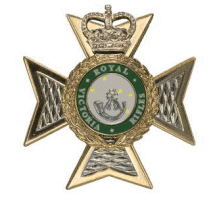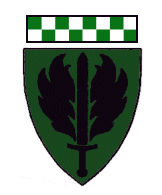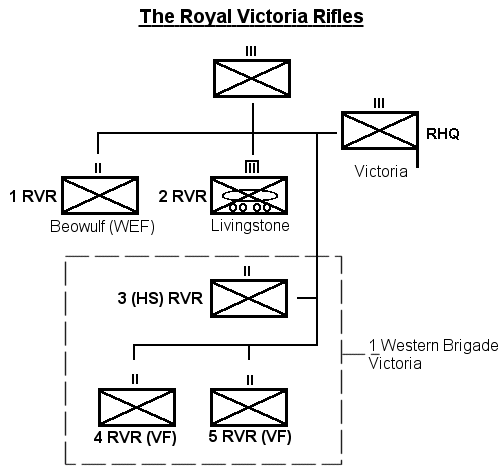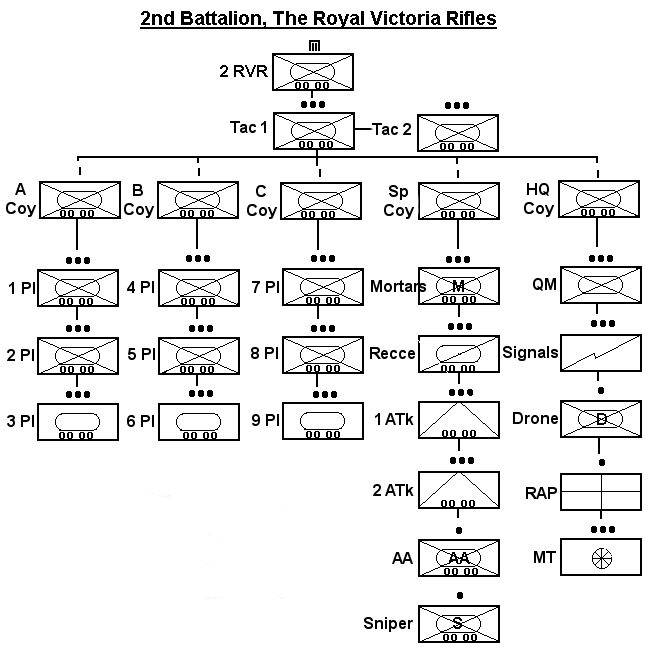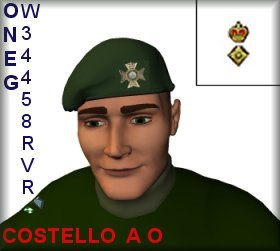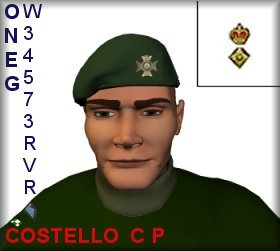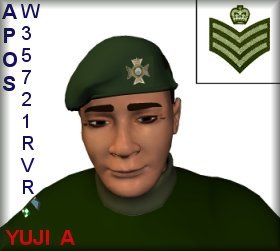Wellon Army: 2300AD
The Royal Victoria Rifles Introduction The Royal Victoria Rifles (RVR) see themselves as the senior-most of the North Albion regiments in the Wellon Army. They trace their roots back to the City of Victoria Militia's Rifle Companies created with the foundation of that city. The regiment is still recruited from Victoria and sees itself as one of the finest infantry formations around and is not backwards about conveying this opinion to other units. The regiment's 1st Battalion is stationed on Beowulf as part of the Wellon Expeditionary Force. Narrative The Alician Light Infantry had a high opinion of their abilities and could barely conceal their contempt of us. In their mind they were hardened, tightly disciplined soldiers tested during countless skirmishes in the Archipelago. We on the other hand were dissolute, soft-living mongrels from decadent Wellon, slack from years of peacetime soldiering. The Riflemen of 1 RVR took to that attitude pretty badly and as a result of one alcohol fuelled brawl harsh discipline was imposed on both battalions in camp. The field phase of the exercise involved both co-operative, force-on-force and counter-Kafer training on the testing Grendal's Moor training area. It was only after this (local) day-long exercise that the ALI began to give us any grudging respect. And that was after kicking their arses from one side of the training area to the other. What they didn't realise was that most of my soldiers were toughened by life in some of the more violent city districts in Wellon, rather then brutal discipline at Depot. That they were honed by excellent basic training as well as the tough Para Battle Cadre. Not to mention we had an Archipelago of our own to conduct operations in. So decadent mongrels we may have been, but we were still as good a set of soldiers as you could find in the Commonwealth. Extract from 'Over The Hills: The 1st Royal Victoria Rifles on the French Arm'
The RVR has its roots in the Alpha Centauri War between the ESA powers and the Argentines. The war rapidly disillusioned the ESA nations of any utopian thoughts of a de-militarised Tirane and plans were laid for garrison forces and local auxiliaries. The British were no exception and when the city of Victoria was created a paramilitary Militia, manned by a draft amongst the colonists, was raised at the same time. However the Militia was disparaged by many as it was tasked and trained more for civil defence and to supplement emergency services than for military operations. One of the leading voices was Catherine Wellon, a famous and respected member of the survey teams who had been cut off on-world during the War. Indeed she had been involved in a stand-off with Argentine commandos. She was now a member of the team establishing the city and had developed political ambitions. She led the argument in favour of developing more militarily capable locally raised units who would be capable of leading irregular military resistance in the absence of regular British forces or operating alongside the British at short notice. By the end of 2171 Catherine Wellon had won a part of the argument. The level of development of the city was too low to support professional soldiers a force was raised from volunteers from the Militia under the auspices of the Commissioner of Victoria. This force, the Independent Company of the City of Victoria Militia, was a company strong and included many former soldiers in its ranks. Although lightly equipped the presence of the ex-servicemen including most of the leadership cadre caused the unit to become effective quickly. Initially, like the rest of the Militia, military training was co-ordinated by the local garrison from the 3rd Battalion, Royal Marines Colonial Light Infantry. However by 2173 the Independent Company had arranged an affiliation with the Royal Green Jackets and had an integral training team from that regiment. Consequently the unit soon began to style itself as the Independent Rifle Company and adopted rifle regiment traditions. In the early years the Independent Company was a voluntary organisation, but one marked by an over-subscription of recruits and so was able to pick and choose who it wanted in its ranks. Training was designed to cover a mix of skills as well as developing survival and other skills in the unusual terrain of Tirane. They often acted as an enemy force for the local garrison, becoming reasonably proficient impersonating an insurgent force. During the Riots of 2174 they were called out onto the streets to back up the police. In 2176, with Catherine Wellon in place as Commissioner another company was raised, being known as the 2nd Independent Rifle Company and the original company becoming known as the 1st IRC. Four years later disaster stuck Victoria when the Gelb Plague broke out in the city and in the badly effected Peel District violence and looting broke out. Commissioner Wellon sent troops in to restore order, although the first troops in were from 3 RMCLI both IRCs were mobilised hours later and sent in under the command of 3 RMCLI. The presence of troops had a calming effect on the situation but over the years of the plague they were responsible for aid to the civil authority, frequently deploying in the city. Local institutions failed badly in the crisis with both the Victoria Colonial Police and Militia proving less than competent and needing reform. Only the Independent Rifle Companies proved reliable, winning and retaining the respect of the British regulars. As a result two more companies were formed, followed in 2285 by a rudimentary HQ Company formed to take some of the pressure of the regular garrison battalions and allow the companies to operate in a co-ordinated manner under their own command. In 2287 Catherine Wellon died, the most prominent victim of the Plague. She was given an official funeral in which the IRCs played their part as part of the burial party. In honour of her support of the unit she was posthumously nominated as Honorary Colonel-in-Chief. In the same year as Catherine Wellon died the British Tirane colonies were re-organised and the territories of North Albion, South Albion and New Scotland were formed to co-ordinate the previously autonomous settlements. Each of the new territories were also to include a Defence Force in which regular locally raised forces were to be a part alongside British units. The first of these units in the North Albion Defence Force were to be formed in Victoria and New Birmingham. In Victoria the Independent Rifle Companies were stripped away from the Militia and combined to form the City of Victoria Rifle Brigade, a battalion sized formation. The CVRB was to be a full-time formation and some restructuring was required. Initially it looked as if the CVRB would loose many key IRC soldiers who had no desire to become regular soldiers. However the CVRB was able to retain a pair of volunteer companies in addition to its three regular ones and reaped the benefits of a wider local base and accessible reserves. The formation of North Albion coincided with a lowering in the acceptance standards for colonists emigrating to British Tirane. A consequence of this decision was a rise in crime in the cities and banditry out in the countryside. By the early 2190s the British Tirane Police was regularly calling on military forces for support and the CVRB was amongst the units deployed, serving frequent tours in the North Albion Plain and in the foothills of the Pendragons. In comparison with the poorly trained militia forces in the area the CVRB was well noted for its professionalism and thanks to the presence of Terran media gained a reputation on Earth as well. Articles about 'rugged colonial soldiers', although an ancient cliché, became somewhat commonplace about the Victoria Rifles. In 2194 the CVRB deployed to the Southern Archipelago in response to the 'Southern Problem' of illegal immigration. Conditions in the tropical islands were very different than the riflemen were used to and they took some time to adjust but this proved much less of a problem than it did for other battalions. In the aftermath of their tour they returned to their home city only to be frequently called out to support the local authorities in tackling the rioting commonplace at the time. This rotation from local bandit suppression, to operations in the South to aid to civil authorities at home became well known the CVRB and posed a strain on the battalion. In 2200 a decision was taken in the higher echelons of the NADF to expand the unit. The existing CVRB was split to form two battalions; the 1st Battalion entirely composed of Permanent Force regulars and slated for high readiness deployment across the colony and a 2nd Battalion of mixed regulars and volunteers stationed in Victoria as a reserve. In July this reorganisation had just been completed when news arrived from Earth that King Henry IX was recognising the service of the unit by bestowing Royal status upon it, only the second colonial unit to be honoured in that way. The unit was consequently re-named the Royal Victoria Rifle Brigade, the name it retained until 2277. In the years running up to the creation of the Dominion of Wellon the decision was taken to create a mobile armoured brigade using units from across the Territories. Consequently in 2237 the 1st RVRB were chosen to represent North Albion in the new unit forming at New Shorncliffe in South Albion. Trained by units from the 4th British Armoured Division on the new Halberdier ACV-APC, in many ways the unit was to be a forerunner of the Wellon Army which would follow in less than a decade. The structure of the RVRB remained somewhat static in the 40 years preceeding the creation of the Dominion of Wellon and the Wellon Army. Indeed the only major change was the creation of the Depot Battalion formed at the sprawling Roberts Barracks in Victoria in 2246, this freed up the 2nd Battalion to become a normal regular battalion capable of deploying anywhere in Wellon. The Depot Battalion comprised both training cadres and the local volunteer companies. They were the most prominent of the locally raised battalions within the NADF and successful in retaining their links with the local community, the RVRB had little difficulty in recruiting and was usually always at full strength. The regiment was very conscious of its place in Victorian society and Guard of Honour duties and Freedom of the City (granted in 2207) parades kept it in the public eye. Recruitment into the rank and file of the regiment came predominantly from the Peel and Canning Districts of the city. The regiment's officer corps was usually found from the wealthier parts of the city although a large proportion of the officers were promoted from the ranks. All in all the RVRB had a high reputation for its professionalism in the Wellon and British Armies, Indeed both 1 and 2 RVRB had served on Earth on exchange with the British Army, setting high standards. The regiment had provided detachments at the burial and coronation of every British monarch since the death of Henry IX, giving it a profile envied by many other regiments in the Wellon Army. By the 2270s the RVRB was a tightly integrated, well balanced unit with a tradition of high standard soldiering. In 2277 in what was to be a fore-runner of the 'New Cardwell' Reforms of the 2285 Defence Review the regulars and volunteers of the RVRB were to be combined with two local militia battalions. The aim was to increase the professionalism of the militia, bring them into a wider regimental 'family' and to tidy up the somewhat confusing system still existent in the area around Victoria. The 4th Battalion was to be formed from the old City of Victoria Militia, for which compulsory service by 'ballot' still existed (although this was removed in 2278), which had long had a bitter rivalry with the RVRB since the days of the Independent Rifle Companies. The 5th Battalion was to be formed from the Narvikshire Rifle Militia a highly professional unit from Cutter's Spur with a high proportion of ex-regulars in its ranks. However the Narvickers wondered just why they were being lumped in with Victoria's regiment. The Depot Battalion was to become the 3rd Battalion. The regiment was simultaneously renamed the Royal Victoria Rifles, which together with the perceived dilution of the quality of the regiment largely alienated the PF soldiers in its ranks. All in all the reforms did nothing for the morale of any of the units comprising the new RVR. Unfortunately the same mistakes were repeated several times in the New Cardwell Reforms. Nevertheless the regiment quickly got back to work with regular soldiers being posted into the former militia units to help bring standards up. The regiment was further effected by the Defence Review when many of its officers and NCOs were posted across to the newly formed Royal Western Regiment of Wellon as a leadership cadre. This denuded the regiment of many of its best soldiers and caused something of a manning crisis in the leadership echelons that has only just been solved. Since the end of the 2270's the regiment has settled into an operational routine which consists of one PF battalion being in either the armoured or light role, the other PF battalion being in the mechanised role with a regional mobile defence brigade and the 3rd, 4th and 5th Battalions being assigned to the local defence brigade. The PF battalions would continue to see service in the Southern Archipelago when serving in the Light Role, with the regiment having undertaken over 20 tours in the area since its formation. In 2294 2 RVR replaced the 1st Royal Doorn Regiment as the Wellonese contingent in the Flanders Peacekeeping Force. The situation in Flanders had greatly improved since the War of Flemish Independence but ethnic strife was still commonplace. 2 RVR provided Observation Posts on the Franco-Flemish border as well as patrols in some of the large cities. The battalion saw no action but was called on to put its riot training into practise on several occasions. In 2298 1 RVR posted a section of Combat Walkers to the 2nd Lion of the Cape Regiment on its force exchange posting with the British 2nd Light Brigade on Beta Canum-5. Consequently these Riflemen would see action with 2 LCR during the Kafer Invasion. Other RVR soldiers on exchange tours with the three British Royal Greenjacket battalions on the French Arm also saw action against the Kafers. One of whom won the Military Cross with 1 RGJ in the Chill Valley Campaign. In response to the Invasion Wellon mobilised an Expeditionary Force for service on the French Arm. 1 RVR was a part of 1 Light Brigade which deployed to Beowulf in 2302 and forms part of the Commonwealth Expeditionary Forces' reserve. Below: Subdued WEF patch and RVR flash as worn by all members of 1 RVR.
The RVR recruit from the City of Victoria and the southernmost part of Cutter's Spur around Narvik. However the regiment is overwhelmingly marked by its links to the city, with Narvickers tending towards the North Albion Greenjackets. The majority of recruits now come from the districts of Peel, Disreali, Canning and Wilberforce. These are usually working class, if well educated and display the outspokenness, bloody mindedness and rough humour typical of those areas. Service within the regiment is well regarded by the citizens of Victoria and a tradition of service has grown up in certain sections of society. Indeed service is often a stepping stone into a well paying job in the financial districts for both officers and other ranks alike. The RVR has never had a major problem recruiting in the city and in fact is often over-recruited, with the over-spill being directed to the Royal Westerns. The reputation of being the RVR's rejects has done nothing for morale in that new regiment. The only part of the regiment with a recruiting problem has been the 4th Battalion which suffered from serious retention problems after 2277 and hasn't quite recovered in spite of cross-posting from 3 RVR's oversubscribed VF companies. Indeed the RVR is better able than most regiments to provide staff for the various training establishments, giving the regiment's profile another boost within the wider army. The ethnic composition of the RVR reflects that of its recruiting area and has a strong minority of people of British descent. The remainder are descended from colonists from across the Commonwealth of Nations and include those of African and Indian extraction. A small but significant number are recruited from the city's Japanese-Amaterasujin community. In general the regiment is as polyglot as only one from a major city can be. It should also be noted that the RVR has enjoyed a virtually monopoly on the running of Wellon Cadet Force detachments in the city. Although not a military force these provide uniformed training for young people, and many Cadets go on to join the WDF. Naturally the RVR gains many recruits thanks to this pre-identification with the regiment. The RVR's policy on officer recruitment since 2277 encourages a quick identification of officer candidates both before and during basic training. Once selected as a potential officer the candidates are posted to 3 RVR for intensive training in advance of being sent to RMANC. Consequently few 'Late blooming' candidates from the ranks are selected and these are generally very good. Whilst many regiments do it differently this system seems to work reasonably well for the RVR and has certainly enabled it to make good its 'losses' of officers to the Royal Westerns faster than most other regiments. All recruits for the RVR undergo training relatively close to their homes, as most come from Victoria. The ten weeks of Phase 1 Training, common across the whole Wellon Defence Force, is usually conducted at one of three centres; Napier Barracks in Victoria, in Alexandra or in Narvik. As Riflemen are mixed in with recruits for all other parts of the Army, as well as the RWN and RWAF, the Phase 1 Training has no particular infantry bias. However the many RVR capbadged instructors at all three establishments attempt to conduct supplementary training and encourage RVR esprit de corps. All PF Riflemen complete their Phase 2 Training at the North Albion Infantry Training Centre in Narvik. This six month training programme is followed by the soldiers being sent on a further number of training courses - notably the Para Battle Cadre for those going to 1 RVR. The RVR do not follow the example of other regiments in nominally posting those on long training courses to the Home Service battalion. In general the regiment is well enough manned to be able to send Riflemen off on an array of courses and not worry about the operational strength of the units. Consequently the regiment is well known for having its soldiers highly qualified in a vast number of obscure fields. Like all Wellonese units the RVR has its affiliations to British regiments and links with foreign units. The RVR has a long links with the Royal Greenjackets and each battalion has and an officer and NCO on exchange tours. The regiment has also conducted exchanges with the 1e and 9e Régiments de Chasseurs de Tirane from Nouvelle Provence and regular battalions of the New Canberra Regiment. The Royal Victoria Rifles are the prototypical New Cardwell Regiment; comprising 2 regular PF battalions, 2 part-time VF battalion and a mixed Home Service battalion. Unlike many regiments the Regimental HQ is not co-located with the HS Battalion, instead it is housed in plush buildings in the centre of the central Albert District of Victoria.
1st Battalion, The Royal Victoria Rifles 1 RVR are a Permanent Force unit which traces its lineage back to the first Independent Company formed in 2171. It is a Light Role Infantry battalion attached to 1 Wellon Light Brigade Group, currently assigned to the Wellon Expeditionary Force and stationed on Beowulf. The battalion is fully up to strength and even includes an integral Battle Casualty Replacement Reserve. Six months prior to deployment the battalion's was rebuilt with some of the weaker leaders and soldiers being replaced by troops from other parts of the regiment. As a result 1 RVR has a very high opinion of itself. The battalion is organised with four rifle companies (A, B, C and D (Patrols)), a fire support company (S), a HQ Company and a BCR company (R). At present R Coy is being used for line of communication purposes but should the battalion be committed to operations it will return to its BCR role in replacing casualties in the rifle companies. Notably 1 RVR has a very strong Combat Walker Platoon with several of its key members having served with the 2nd Lion of the Cape Regiment on New Africa during the Invasion. On Beowulf the battalion has concentrated on the counter-Kafer role with the emphasis on possible defensive operations on Beowulf or counter-insurgent operations elsewhere in the French Arm. However recently more offensive operations have been rehearsed, possibly suggesting operations on the Eta Bootis finger or beyond. |
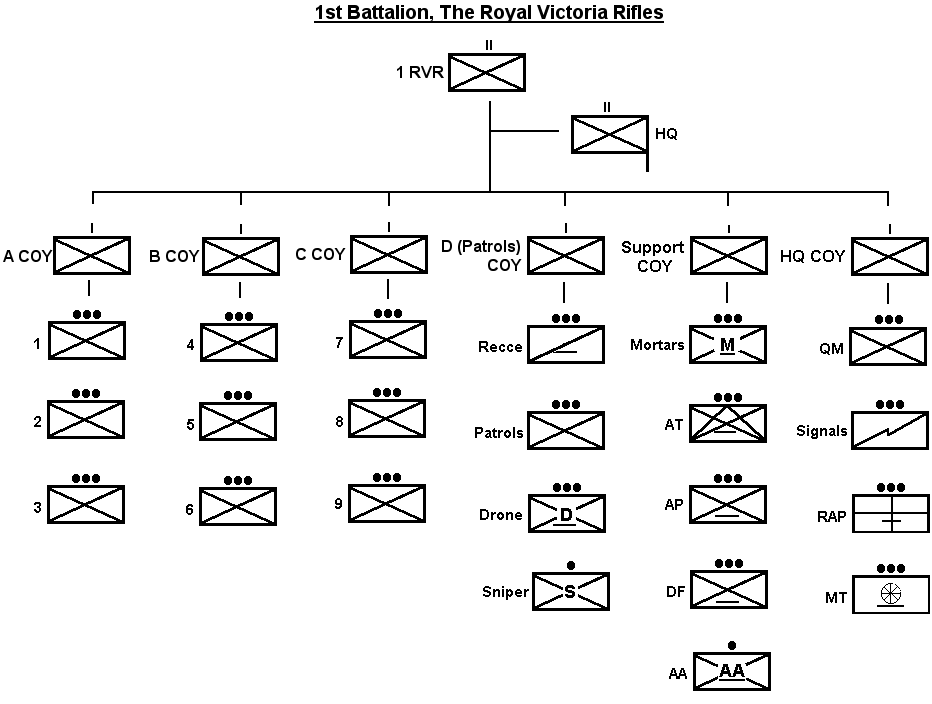
|
2nd Battalion, The Royal Victoria Rifles 2 RVR are a Permanent Force light mechanised battalion belonging to 4 Mech Brigade of the newly organised 15th (Wellon) Mechanised Division and is stationed near Livingstone in South New Albion. It is equipped with the highly mobile Redkat series of AFV which have recently replaced most of the division's ageing WMV Hussars. The battalion was formed in 2200 as a home service unit but became a regular PF battalion in 2246. Currently the battalion is highly trained and in the middle of a fearsome training schedule. The CO has taken badly the attitude of several former 1 RVR officers and NCOs following that unit's deployment to the French Arm. Mutterings about being 'second rate rejects' have been met with disgust and a desire to prove the battalion is in no way inferior to 1 RVR. The battalion follows the mechanised order of battle with three mixed companies (A, B and C) in addition to HQ and Support Companies. Currently the Companies have two infantry platoons equipped with the Redkat IFV and a platoon equipped with the Hussar tank destroyer variant. It is hoped to replace these with either Redkat AT, Redkat FS or a mooted Redkat TD variant in the not too distant future.
3rd (Home Service) Battalion, The Royal Victoria Rifles 3 RVR was once the RVRB's Depot Battalion and is still based at Roberts Barracks on the outskirts of Victoria. Unlike many other regiments' Home Service Battalions 3 RVR spends relatively little time running training cadres and concentrates on its Home Defence Role, where alongside the 4th and 5th Battalions 3 RVR forms 1 Western Brigade. Consequently it is one of the more combat effective of HS units and is readily field deployable at low levels of notice. The battalion is also fortunate to have a significant number of WMV Hussar APCs in its inventory and so can act in a light mechanised role if required. 3 RVR is organised with two PF (A & B) and two VF Rifle (No.1 & No.2) Companies with mixed HQ and Support Companies. The last two are on cadre basis compared with front-line units but are effective formations. The battalion is over-strength in Local PF and VF personnel and indeed provides manpower to bulk up 4 RVR. 3 RVR is most visible in the community by its constant recruiting activity, its participation on civic occasions and parades. It also has several organised sports teams that compete in local leagues. 4th (City of Victoria) Battalion (VF), The Royal Victoria Rifles 4 RVR has its roots in the City of Victoria Militia formed in 2171 and is undoubtedly the 'problem child' of the regiment. With its long history, distinctive traditions and long running rivalry with the RVRB the amalgamation of 2277 did not go well. The higher officer and NCO echelons of the Militia resigned en-masse at the reshaping of the unit and the 'forcing' of Rifles units and traditions on it. Consequently retention of the rank and file members was also very poor. In response the battalion was reinforced with drafts from 3 RVR, but this only increased the difficulties with retention. Today 4 RVR has almost entirely lost its Militia traditions and identifications, being remade as a Rifles battalion, but somehow the aftermath of 2277 still lingers. Potential VF soldiers almost inevitably join one of 3 RVR's VF companies in preference to 4 RVR, and have to be posted to 4 RVR which damages retention and continuity. The battalion's performance in the field has always lagged behind that of 3 and 5 RVR, with obvious effects on morale. The battalion is conventionally organised with four rifle companies (A, B, C and D) with Support and HQ companies. It is a light role formation equipped only with soft-skinned vehicles. 5th (Narvikshire Rifle Militia) Battalion (VF), The Royal Victoria Rifles 5 RVR was formed in 2277 from the Narvikshire Rifle Militia, based around the garrison town of Narvik to the south-west of Victoria. The NRM was one of the more highly regarded Militia units, thanks largely to its mixture of hardy Narvickers and ex-soldiers from the garrison who settled in the area. Its integration into the RVR was quick, although 5 RVR has always taken much of the self-regard of the RVR with a pinch of salt. Like 4 RVR the battalion is in the light role and is equipped only non-armoured vehicles. It has three rifle companies (A, B and C) with small HQ and Support Companies. Lt Colonel Alexander Costello
Lt Col Alex Costello commands the 1 RVR Battle Group currently stationed on Beowulf as part of the Wellon Expeditionary Force. He is a highly professional officer but one who leads his command with good humour and humanity. Alex Costello was born in Victoria into the sprawling Costello family which had a tradition of service with the regiment since its formation. Indeed Alex is one of five siblings, of whom all have served in the regiment and his younger brother is currently CO of 2 RVR. This is the first time in the Wellon Army this has happened. Educated at the prestigious Queen Ann's Grammar School and Catherine Wellon University he has served with the regiment as a Cadet, VF and PF soldier. Alex has enjoyed a smooth progression up the ranks, being commissioned from RMANC soon after graduation. His career path has been that of an armoured/mechanised infantry specialist so it is somewhat strange he has ended up commanding a light role battalion. He has served on several Staff posts in his career at both Division and WMoD level and is meticulous in such work as well as being well known in the higher echelons. Happily married with three children, he is an accomplished yachtsman and amateur military historian. He is a well liked CO and has a genuine concern for the well being of his troops. Lt Colonel Charles Costello
The commander of 2 RVR stationed near Livingstone in Southern New Albion, Charlie Costello is the brother of CO 1 RVR. A driven officer with a great deal of unconventional service, Charlie is pushing 2 RVR to even higher standards. Born a year after Alex at the family holdings in Hamoazeshire, Charlie has always striven to outdo his elder brother. Indeed whilst Alex attended University locally in Victoria, Charlie won a scholarship to the Université de Tirane in Mirambeau. Similarly Charlie gained his commission from Sandhurst on Earth, yet the seeming disinterest of Alex only pushed him on. His career in the RVR has been a varied one, with several years away from the regiment. In his early years he gained a reputation as a 'Badge Collector' attending a range of courses including Commando, Mountain and Jungle specialisations. He has also served as a company commander in the Royal Westerns whilst a Captain and later served as 2i/c of the 5th Bn, New Africa Regiment on Beta Canum-V. Although not seen as being in pole position to command a battalion he got his chance thanks to the resignation of another officer. So far he has made an exemplary job of running 2 RVR. Charlie is respected, but not liked by the men of the battalion. However he is popular with his fellow officers. A career soldier, he is unmarried. Colour Sergeant Aida Yuji
C/Sgt Yuji commands 1 RVR's Combat Walker Platoon. A veteran who commanded a CW section with 2 LCR he is both highly trained and has significant combat experience. In fact he holds his position in front of several senior soldiers. Aida Yuji is a 3rd generation Japanese-Amaterasujin born and raised in the Gladstone District of Victoria. A graduate of Victoria Tech he joined the RVR with the aim of becoming an officer, but instead developed into an excellent NCO. A skilled AFV gunner he was one of the first Wellonese to train on CW's at ITC Catterick in the mid 2290's and undertook and passed the testing CW Tactical Instructor course in 2299. Shortly afterwards he was assigned to command the RVR CW Section seconded to the LCR on New Africa. He commanded this element throughout the Invasion and was Mentioned in Dispatches on no fewer than three occasions. After repatriation and a short period of leave he was brought back to take command of 1 RVR's CW Platoon. Aida Yuji is a first class combat walker pilot with an excellent understanding of warfare against the Kafers. However he has proved less adept at training and administrating a platoon out of combat and he relies heavily on his 2i/c. Aida Yuji's off-duty drinking is near legendary and has intensified since his return from New Africa. This has led him to become estranged from his wife and child. The RVR have a rifle green beret as its standard headgear. Upon this is worn the regiment's capbadge which depicts a crowned Maltese Cross, typical of rifle regiments, together with the bugle of light infantry and the Great Bear constellation of stars found on the Wellonese flag. The other immediately noticeable item of uniform is the Sash, worn with every order of dress except when in the field. The Sash is a strip of silk in the checked White and Green chequer-board design of the City of Victoria. The Sash is worn around the waist and tied in the so called 'Rifle Knot' at the back, it replaces the Stable Belt worn by most other regiments. Below: Example of the pattern found on an RVR Sash.
The RVR finds itself on parade more frequently than perhaps any other regiment bar the Wellon Guards or NCLI. It does so in its distinctive rifle green Service Dress, worn naturally with the Sash. When in Service Dress the regiment wears a form of Scottish Glengarry side cap - this is black but with a diced band of white and green around it. As befits a regiment in the light infantry tradition the RVR has buglers instead of a traditional band. As mentioned above the RHQ is in the centre of Victoria, one of its major features is the 'Regimental Mess'. This is a facility that is open throughout the day and late into the evening and consists of a high class restaurant and a number of bars. It is open to any serving and former Rifleman of any rank and their guests. It is always crowded at lunch time and is often used by Victorian businessmen to 'wine and dine' their non-Victorian colleagues. This raises the profile of the regiment whilst providing it with a handy level of income from outside of the WMoD. Similarly some of this income goes to the upkeep of the Regimental Chapel in Victoria Cathedral. Copyright 2009, Dan Hebditch |
